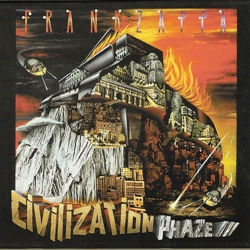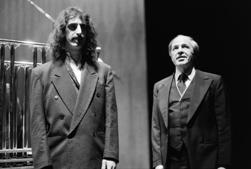
Frank Zappa:
Civilization Phaze III
Frank Zappa, Ensemble Modern
Barking Pumpkin
2 CDs, realized 1991–93
Buy at Amazon.com
Zappa's crowning work
The Civilization Phaze III CDs have long been expensive and hard to find, though as of late 2016 you can listen to the work for free on YouTube. However you get to it, it's worth the two-hour investment. This is one of Zappa's most unique and fascinating works, blowing away most everything else that he produced in the last decade of his life.
CP3 is described as a two-act opera, and indeed it can be viewed as an adaptation of the centuries-old operatic practice of recitative + aria. It's short on conventional singing though: the "recitatives" here are spoken word passages lasting a minute or so, recorded by having the actors talk into a piano with the dampers lifted. (Since the earliest of these recordings actually date from the late 1960s, Zappa appears to have priority over George Crumb's more famous exploitation of this piano resonator effect in Ancient Voices of Children, composed in 1970.) The "arias", ranging from one to 18 minutes, were created on Zappa's Synclavier using a combination of sampled and synthesized sounds, with 30% of Act Two purportedly comprising "pure" recordings of Ensemble Modern performing instrumental music specifically composed by Zappa for the project. In reality it's hard to tell what's pure and what's processed since Zappa makes extensive use of the Synclavier's direct-to-disk capabilities (essentially very long "samples"). But regardless, the arias are almost entirely untexted — even where there are vocal sounds, they’re usually wordless. The arias do purport to advance a pseudo-narrative arc by depicting "actions" foreshadowed by the preceding recitatives, but I see no evidence that Zappa actually intended this work to be staged, (though I suppose you could make a filmed or animated version that freely treats the surrealist story elements: the "living piano", the pig musicians and so on. Both the recitative texts, and the ostensible aria actions are laid out verbatim in the accompanying CD booklet.
The finished piece, which consumed the last three years of Zappa's cancer-shortened life, was mastered and released posthumously in 1994 by the Zappa Family Trust. Musically it represents Zappa at his most complex, melding the modernist style of his composed "classical" pieces with the genre of electronic music pioneered by the likes of Berio, Stockhausen and (especially) Varèse. Headphones are essential for this music, which makes extensive use of stereophony as a parameter (e.g., in the frequent rotational panning of individual sustained notes played by the Ensemble Modern musicians).
Act 1
After the first verbal recitative ("This is Phaze III..." "Well, get through Phaze I and II first."), the music starts off with Put a Motor in Yourself, a relatively straightforward pitch-oriented Synclavier piece with irregular rhythms. You could easily imagine the opening riff serving as an improv vehicle for Zappa's Roxy-era bands...
...though when the "tune" comes atop this, it's in parallel fourths, very much a synthesizer-ism (parallel voice tracking at an arbitrary interval being a pretty standard feature for this kind of digital instrument):
They Made Me Eat It simulates the sound of an (atonal) jazz trio, with Nancarrow-like "impossible" runs in the sampled piano, and portamentos in the sampled bass. Reagan at Bitburg is in a conventional ABA' form, with the A sections being more rhetorical, and the B section being more animated and offering some Zappaesque cartoonish licks interpolated into an otherwise more "serious" texture. The first A section marks the debut of a cimbalom sample that returns in later movements. In Congress Shall Make No Law, the Zappa Family Trust included a brief Reagan At Bitburg Some More track (the only original music on that album) which appears to be a sketch for this aria.
Amid all this unmetered and irregularly-metered music, Navanax (named after a type of sea slug), seems to offer a contrast, beginning with a clear triple time riff in electric bass and guitar:
It doesn't last long, though, as the irregular meters and Nancarrowish runs quickly return in a variety of instrumental timbres. The remainder of this brief track is basically a succession of variations on the guitar/bass opening.
Xmas values is next, conjuring up the curious sound world in Simon Stockhausen's recording of his father's piece Solo: 1990s style commercial synthesizer patches applied to Darmstadt School atonality. This is one of Zappa's finest pointillist pieces, worthy of the post-Webern milieu of Boulez, Feldman and late Stravinsky. Here Zappa alternates unmetered music with passages built on a steady beat, the latter emphasizing cimbalom and other struck/plucked string instrument sounds. It reminds me of Stravinsky's atonal cimbalom lines in Renard, as well as the mandolin and guitar parts that often crop up unexpectedly in the early atonal chamber works of Schoenberg and Webern. The rhythmically irregular passages feature Zappa's trademark atonal skips in unison woodwinds (reminiscent of Stockhausen's Formel). Throughout CP3, you'll hear little whiffs here and there of things like honky tonk or Hollywood jingles, but Zappa suppresses the sudden transitions into commercial-style music that are so often found in his earlier composed pieces.
Amnerika (originally from Thing-Fish) has a hocketed accompaniment where the same minor second gets traded among instruments, darting around the stereo panorama. Over this is heard a more lyrical, plaintive and tonal melody, though with a similar klangfarben instrumentation. It's like John Adams with a more imaginative use of stereophony. Very little of Zappa's music seems to bear the influence of minimalism and post-minimalism, but this is an intriguing exception. The liner notes to the corresponding track on Everything Is Healing Nicely (another posthumous album, basically "the making of CP3") mistakenly associate hockets with Baroque music, whereas they're actually more characteristic of late Medieval music (e.g., Machaut's Hoquetus David).
The first act ends with N-Lite, which despite the title is actually the longest of the arias at 18 minutes. It begins with an unmetered cadenza for sampled clarinet, where a falling minor third is prominent:
This cadenza + accompaniment texture continues for several minutes, often with the lead passing from clarinet to other sampled instruments. Sounds of gurgling come in at about 5:50 (they're supposed to represent "stage water" whose waves drown the landmark buildings of Venice). Sporadic vocal sounds come in around 7:12 amid a return of plucked/struck string samples. At the eight minute mark, the rapid notes of the opening transform into piano runs of Nancarrowish dimensions that dissolve into a Varèse-like collage of unmetered processed percussion. At about 9:45 there's a brief hint of the Strictly Genteel tonal side of Zappa, but we quickly return to atonal cadenzas, now punctuated by siren-like sounds (another Varèse-ism). The texture gets thicker, with the preceding elements coming together in quicker succession, reminiscent of Boulez's Third Improvisation on Mallarmé, but with a synthetic drum kit added. At 15:35 this reaches an end with a brief passage in blues rhythm that subsides before giving way to a final piano cadenza that culminates with B♮ in octaves capped by a glockenspiel on top.
Act 2
So far the music, although complex, has basically been pitch- and sometimes rhythm-oriented. With Act Two, though, timbre starts to assert itself as an equal parameter. The brief first aria, Secular Humanism, emphasizes sampled and processed spoken voice sounds amid the familiar instrumental pointillism. I Was In A Drum, predictably, emphasizes drums and an acoustic bass. It's still hard to tell what's based on short samples as opposed to longer excerpts from the Ensemble Modern recordings, but there seem to be both kinds of source material in use here, and indeed Zappa's technique of combining a through-recorded instrument with its sampled counterpart is an interesting contribution to the unique timbral environment of CP3. A Pig with Wings is a throwback to the synthesized plucked string sounds of Xmas values, and these sounds return again in Gross Man where they're combined with woodwinds.
After a few more short tracks, we come to the extended Dio Fa, which features Tuvan throat singing (uncredited on the album but thought to be the voices of the Huun-Huur-Tu quartet). At first we hear a solo male singer accompanied by sampled instruments. It's here that Zappa begins to vividly embrace the collage-oriented aesthetic of electronic music epitomized by Varèse's Déserts and Poème électronique. Eventually the Tuvan voice is looped to form a new growling instrument that's combined with "purer" male and female choral voices in a kind of stretto, with sustained bowed bass sounds creating an effect reminiscent of the ending to Stockhausen's Hymnen.
Beat the Reaper is a nine-movement suite, continually accompanied by
the sound of falling water in the right channel. I wish I could hear this music without the
constant "rain" that strikes me as overbalanced and overlong
despite its ostensible dramatic
rationale (a thunderclap that occurs just before the
music starts). One of
the movements of Beat the Reaper (starting at 5:43) is clearly
inspired by Ligeti's "metronome" pieces such as the third movement
from his Second String
Quartet. Eventually the suite dissolves into the final aria, Waffenspiel (weapons play), which is
built exclusively from outdoor recorded sounds
(gunshots, cars, thunder, and other mechanical sounds), the only such
track in the opera (the other arias all have plenty of definite-pitch
material). The guns ultimately give way to birds chirping and dogs
barking, though there's a very faint musical sound concentrated in the left
channel (a distant marching band perhaps), suggesting that we're still in a
human-populated landscape ("life goes on outside the piano"). The
other obvious connotation is the quiescence of imminent death, an obvious
reference to Zappa's failing health. It's with these gentle sounds that the
opera ends, a soft conclusion that makes a stunning
musical valedictory gesture, far from the boisterous chords of Muffin Man,
Strictly Genteel or other traditional Zappa closing numbers.

FZ and Boulez
In perspective
One's biggest misgivings about CP3 are likely to be with its spoken word recitatives, which are in the style of the conversational interpolations in the great Mothers of Invention-era collage albums, but don't come off as well here. Partly it's because Zappa is ostensibly trying to pull together a dreamlike narrative that isn't adequately supported by the material, and partly it's because this technique simply works better with brief funny snippets than with extended surrealist dialogues. Whereas the verbal material in We're Only In It For The Money sounded playful and transgressive, CP3's texts sound portentous, closer in caliber to the "penalty tracks" appended to the posthumous Uncle Meat CD reissue. I approach CP3 like I would one of those 18th century operas with dull recitativos and a hackwork libretto that's nevertheless redeemed by its admirable music. At least the texts in CP3 are free of the puerile misogyny that disfigures many Zappa albums. And the Ensemble Modern musicians sound wonderful throughout.
Zappa clearly considered CP3 his crowning achievement, in the mold of Bach's Musical Offering or Messiaen's St. Francis. There's some indication that he hoped it would help listeners acquainted only with commercial music ease themselves into the musical richness of modern Western art music. During his infamous U.S. Senate testimony on racy lyrics in popular music, he said: "Why not bring jazz or classical music into your home instead of Blackie Lawless or Madonna?". Regardless, of all Zappa's through-composed and fixed-media works, CP3 is the one that maybe, just maybe, can stand without apology alongside its models in the pantheon of the late 20th century's finest musical works.
- Michael Schell
First published October 2010, revised December 2016
I recommend Kasper Sloots' page for additional analysis and transcriptions of CP3.
![]()
Selected writings |
Schellsburg home
Jerry Hunt |
cribbage
![]()
Original Material and HTML Coding Copyright © 2010–16 by
Michael Schell. All Rights Reserved.



